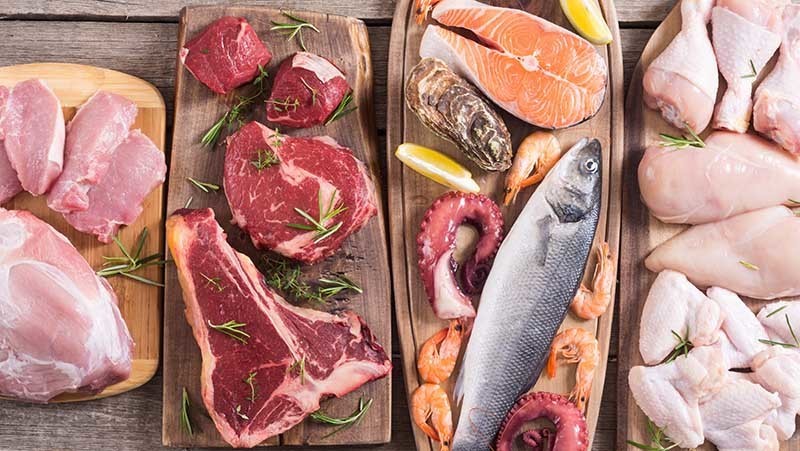The Ultimate Guide to Meat Temperatures for Cooking at Home

A Guide to Internal Temperatures for Meat, Poultry, and Seafood When Cooking at Home
There is nothing like cooking or sharing a meal to help make you feel like everything is going to be okay. Dining out may not be on the agenda tonight, but we all have to eat. So while our culinary team at Seared can’t be there to serve you, we still want to help ensure your home-cooked meals are prepared deliciously and safely.
Meat Temperature Safety Recommendations
This guide will help you measure internal meat temperature correctly based on current food safety regulations provided by the USDA. We also outline the minimum cooking temperatures and rest time for meat, poultry, seafood, as well as their different degrees of doneness.
What is Meat Doneness?
Meat doneness is an industry term that we use a lot in the kitchen at Seared. It refers to the degree at which the meat is prepared, and is expressed by whether it is cooked rare, medium, medium-well, or well-done. So when your server asks you, “How would you like your steak cooked tonight?”, they are referring to the meat doneness.
Why Does Meat Have to Rest After Cooking?
The USDA recommends a specific minimum internal temperature of certain meats after they have been removed from heat and left to rest for three minutes before being eaten. This ensures it is a safe temperature to be consumed by killing off any potentially harmful germs or pathogens.
This rest time also allows the flavorful juices to redistribute throughout the meat and be reabsorbed. This leaves every bite delicious and moist.
How Do You Measure the Internal Temperature Of Meat?
When cooking meat at home you will need a meat thermometer. This will help ensure the meat reaches the safe minimum internal temperature.
Instant-read thermometers are the most commonly used temperature tools and can be found at most grocery stores. They give you temperature readings fast and clearly, but can not be left in meat while it is cooking. Use this type of food thermometer at the end of the minimum cooking time and after the suggested rest period.
Dial thermometers are commonly used in roasts and can remain in the meat while cooking but are not appropriate for thin cuts of meat.
To get the most accurate reading, you will want to insert the thermometer into the thickest part of the meat, which is usually the center of the cutlet or breast of the turkey or chicken. Avoid bone or fat when checking the temp and if the meat product is irregularly shaped, take the reading in several places.
Internal Meat Temperature and Doneness Guide
The information below will let you know the recommended meat cooking temperatures, as well as the guide to doneness and the corresponding temperatures.
Whole Beef Steak Cooking Temperature
The USDA safe internal cooking temperature recommendation of whole beef is 145°F after a 3-minute rest.
Steak Doneness Temperature Guide
- Rare: 125°F
- Medium-Rare: 130°F
- Medium: 140°F
- Medium-Well: 150°F
- Well-Done: 160°F
Ground Beef Cooking Temperature
The USDA safe internal cooking temperature recommendation for ground beef or hamburger meat is 160°F.
Ground Beef Doneness Temperature Guide
- Medium-Rare: 125°F
- Medium: 130°F
- Medium-Well: 140°F
- Well-Done: 160°F
Fish and Shellfish Cooking Temperature
The USDA safe internal cooking temperature recommendation for fish is 145°F. There are no degrees of doneness for fish or shellfish.
Poultry Cooking Temperature
The USDA safe internal cooking temperature recommendation for all poultry is 165°F. And you guessed it, there are no degrees of doneness for turkey or chicken.
Pork Cooking Temperature
The USDA safe internal cooking temperature recommendation for pork is 145°F after a 3-minute rest.
Pork Doneness Temperature Guide
- Medium: 150°F
- Well-Done: 160°F
Lamb Cooking Temperature
The USDA safe internal cooking temperature recommendation for lamb is 145°F after a 3-minute rest.
Lamb Doneness Temperature Guide
- Rare: 125°F
- Medium-Rare: 130°F
- Medium: 140°F
- Medium-Well: 150°F
- Well-Done: 160°F
Veal Cooking Temperature
The USDA safe internal cooking temperature recommendation for veal is 145°F after a 3-minute rest.
Lamb Doneness Temperature Guide
- Rare: 125°F
- Medium-Rare: 130°F
- Medium: 140°F
- Medium-Well: 150°F
- Well-Done: 160°F
Seared Steak and Seafood in Petaluma
Our entire team at Seared takes safety and sanitation very seriously. While our doors may be closed for the time being, we still want to help bring some consolation to our community. We encourage everyone to stay inside and enjoy a well-prepared meal at home.
During times of uncertainty, the act of creating and sharing a meal can bring great comfort to everyone. From all of us at Seared, we look forward to seeing you again soon, but in the meantime, follow us on our Facebook and Instagram for the latest restaurant news and updates!
